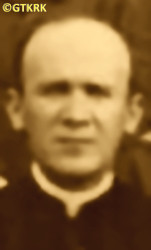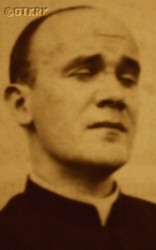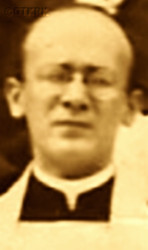Roman Catholic
St Sigismund parish
05-507 Słomczyn
85 Wiślana Str.
Konstancin deanery
Warsaw archdiocese, Poland
full list:
displayClick to display full list

searchClick to search full list by categories
wyświetlKliknij by wyświetlić pełną listę po polsku

szukajKliknij by przeszukać listę wg kategorii po polsku

Martyrology of the clergy — Poland
XX century (1914 – 1989)
personal data
surname
WAGNER
forename(s)
Nicholas (pl. Mikołaj)
function
diocesan priest
creed
Latin (Roman Catholic) Church RCmore on
en.wikipedia.org
[access: 2014.09.21]
diocese / province
Vilnius archdiocesemore on
en.wikipedia.org
[access: 2013.05.19]
Łomża diocesemore on
www.kuria.lomza.pl
[access: 2012.11.23]
Mogilev archdiocesemore on
en.wikipedia.org
[access: 2013.06.23]
RC Military Ordinariate of Polandmore on
en.wikipedia.org
[access: 2014.12.20]
date and place
of death
08.02.1942

Jambyltoday: Taraz, Jambyl reg., Kazakhstan
more on
en.wikipedia.org
[access: 2022.01.06]
details of death
In c. 1924, left Bolshevik Russia, in an unknown circumstances arrived in Poland and continued his theological studies at the Mission Institute in Lublin, founded that year.
After German and Russian invasion of Poland in 09.1939 and start of the World War II, after start of Russian occupation, arrested by the Russians in 01.1940, during customary, traditional Christmas time „carol” visits to his parishioners in Narewka (one of them was Danuta Siedzikówna „Inka”, later nurse, murdered by Commie‐Nazi regime in 1946 — she was then 17 — in Gdańsk).
According to parishioners arrested because of conflicts with local Jews. In 1921, Jews made up 63% of the town's population, Orthodox Christians 20%, Catholics 17%, and in 1939 among the Russian occupiers there was also a large percentage of Jews (Poles were basically excluded from managerial positions).
Held in custody in Narewka.
From there transported to Bielsk Podlaski prison and next to Brześć on Bug.
There on 01.02.1941 sentenced to 10 years of slave labour in Russian concentration camps — Gulag.
On 11.06.1941 transported to one of Altay country concentration camp.
There slaved at forest clearances.
After German attack on 22.06.1941 of their erstwhile ally, Russians, and an amnesty for Poles in 08.1941 released.
Totally exhausted (according to some sources lost sight) managed to reach Polish army of Gen. Anders forming in Kazakhstan.
There nominated acting chaplain of the Armor Weapons Training Centre but soon succumbed from exhaustion to typhus and perished. The Centre began its operations after his death, on 15.02.1942, in the town of Kayyngdy in Kyrgyzstan.
cause of death
extermination
perpetrators
Russians
sites and events
GulagClick to display the description, BrześćClick to display the description, Ribbentrop‐MolotovClick to display the description, Pius XI's encyclicalsClick to display the description
date and place
of birth
1903

Sankt Petersburgtoday: Saint Petersburg city, Russia
more on
en.wikipedia.org
[access: 2020.07.31]
parents
WAGNER Stanislav
🞲 ?, ? — 🕆 ?, ?

🞲 ?, ? — 🕆 ?, ?
presbyter (holy orders)
ordination
1927

positions held
1942
RC military chaplain — Tank Training Centre, Polish Armed Forces in Soviet Russia (i.e. Anders Army), Polish Armed Forces — appointee
1937 – 1940
parish priest — Narewkatoday: Narewka gm., Hajnówka pov., Podlaskie voiv., Poland
more on
en.wikipedia.org
[access: 2021.09.29] ⋄ St John the Baptist RC parish ⋄ Vawkavysktoday: Vawkavysk dist., Grodno reg., Belarus
more on
en.wikipedia.org
[access: 2022.01.06] RC deanery
1932 – 1937
parish priest — Skribovtsytoday: Bolshoe Mozheikovo ssov., Shchuchyn dist., Grodno reg., Belarus
more on
be.wikipedia.org
[access: 2023.01.18] ⋄ Christ the King RC parish ⋄ Lidatoday: Lida dist., Grodno reg., Belarus
more on
en.wikipedia.org
[access: 2021.09.29] RC deanery
1930 – 1932
vicar — Dzyatlavatoday: Dzyatlava dist., Grodno reg., Belarus
more on
en.wikipedia.org
[access: 2022.01.06] ⋄ Assumption of the Blessed Virgin Mary RC parish ⋄ Dzyatlavatoday: Dzyatlava dist., Grodno reg., Belarus
more on
en.wikipedia.org
[access: 2022.01.06] RC deanery
1927 – 1930
priest — Jasienicatoday: Ostrów Mazowiecka gm., Ostrów Mazowiecka pov., Masovia voiv., Poland
more on
en.wikipedia.org
[access: 2021.12.18] ⋄ St Rock the Confessor RC parish ⋄ Ostrów Mazowieckatoday: Ostrów Mazowiecka gm., Ostrów Mazowiecka pov., Masovia voiv., Poland
more on
en.wikipedia.org
[access: 2021.12.18] RC deanery
1924 – c. 1927
student — Lublintoday: Lublin city pov., Lublin voiv., Poland
more on
en.wikipedia.org
[access: 2021.08.20] ⋄ Mission Institute
student — Sankt Petersburgtoday: Saint Petersburg city, Russia
more on
en.wikipedia.org
[access: 2020.07.31] ⋄ philosophy and theology, Metropolitan Theological Seminary
others related
in death
CHRABĄSZCZClick to display biography John, GULClick to display biography Peter, HOŁYŃSKIClick to display biography Anthony Alexander, RADKIEWICZClick to display biography Steven (Fr Anatol of Immaculate Conception of the Blessed Virgin Mary), SORYSClick to display biography Francis
sites and events
descriptions
Gulag: The acronym Gulag comes from the Rus. Главное управление исправительно‐трудовых лагерей и колоний (Eng. Main Board of Correctional Labor Camps). The network of Russian concentration camps for slave labor was formally established by the decision of the highest Russian authorities on 27.06.1929. Control was taken over by the OGPU, the predecessor of the genocidal NKVD (from 1934) and the MGB (from 1946). Individual gulags (camps) were often established in remote, sparsely populated areas, where industrial or transport facilities important for the Russian state were built. They were modeled on the first „great construction of communism”, the White Sea‐Baltic Canal (1931‐1932), and Naftali Frenkel, of Jewish origin, is considered the creator of the system of using forced slave labor within the Gulag. He went down in history as the author of the principle „We have to squeeze everything out of the prisoner in the first three months — then nothing is there for us”. He was to be the creator, according to Alexander Solzhenitsyn, of the so‐called „Boiler system”, i.e. the dependence of food rations on working out a certain percentage of the norm. The term ZEK — prisoner — i.e. Rus. заключенный‐каналоармец (Eng. canal soldier) — was coined in the ITL BelBaltLag managed by him, and was adopted to mean a prisoner in Russian slave labor camps. Up to 12 mln prisoners were held in Gulag camps at one time, i.e. c. 5% of Russia's population. In his book „The Gulag Archipelago”, Solzhenitsyn estimated that c. 60 mln people were killed in the Gulag until 1956. Formally dissolved on 20.01.1960. (more on: en.wikipedia.orgClick to attempt to display webpage
[access: 2024.04.08])
Brześć: In 1939‐1941 Russian prison. After recapturing of the town in 1944 Russias set up in Brześć a transit camp where they have incarcerated thousands of Poles before sending them further east into Russia (Siberia). (more on: www.kresy.plClick to attempt to display webpage
[access: 2013.08.17])
Ribbentrop‐Molotov: Genocidal Russian‐German alliance pact between Russian leader Joseph Stalin and German leader Adolf Hitler signed on 23.08.1939 in Moscow by respective foreign ministers, Mr. Vyacheslav Molotov for Russia and Joachim von Ribbentrop for Germany. The pact sanctioned and was the direct cause of joint Russian and German invasion of Poland and the outbreak of the World War II in 09.1939. In a political sense, the pact was an attempt to restore the status quo ante before 1914, with one exception, namely the „commercial” exchange of the so‐called „Kingdom of Poland”, which in 1914 was part of the Russian Empire, fore Eastern Galicia (today's western Ukraine), in 1914 belonging to the Austro‐Hungarian Empire. Galicia, including Lviv, was to be taken over by the Russians, the „Kingdom of Poland” — under the name of the General Governorate — Germany. The resultant „war was one of the greatest calamities and dramas of humanity in history, for two atheistic and anti‐Christian ideologies — national and international socialism — rejected God and His fifth Decalogue commandment: Thou shall not kill!” (Abp Stanislav Gądecki, 01.09.2019). The decisions taken — backed up by the betrayal of the formal allies of Poland, France and Germany, which on 12.09.1939, at a joint conference in Abbeville, decided not to provide aid to attacked Poland and not to take military action against Germany (a clear breach of treaty obligations with Poland) — were on 28.09.1939 slightly altered and made more precise when a treaty on „German‐Russian boundaries and friendship” was agreed by the same murderous signatories. One of its findings was establishment of spheres of influence in Central and Eastern Europe and in consequence IV partition of Poland. In one of its secret annexes agreed, that: „the Signatories will not tolerate on its respective territories any Polish propaganda that affects the territory of the other Side. On their respective territories they will suppress all such propaganda and inform each other of the measures taken to accomplish it”. The agreements resulted in a series of meeting between two genocidal organization representing both sides — German Gestapo and Russian NKVD when coordination of efforts to exterminate Polish intelligentsia and Polish leading classes (in Germany called «Intelligenzaktion», in Russia took the form of Katyń massacres) where discussed. Resulted in deaths of hundreds of thousands of Polish intelligentsia, including thousands of priests presented here, and tens of millions of ordinary people,. The results of this Russian‐German pact lasted till 1989 and are still in evidence even today. (more on: en.wikipedia.orgClick to attempt to display webpage
[access: 2015.09.30])
Pius XI's encyclicals: Facing the creation of two totalitarian systems in Europe, which seemed to compete with each other, though there were more similarities than contradictions between them, Pope Pius XI issued in 03.1937 (within 5 days) two encyclicals. In the „Mit brennender Sorge” (Eng. „With Burning Concern”) published on 14.03.1938, condemned the national socialism prevailing in Germany. The Pope wrote: „Whoever, following the old Germanic‐pre‐Christian beliefs, puts various impersonal fate in the place of a personal God, denies the wisdom of God and Providence […], whoever exalts earthly values: race or nation, or state, or state system, representatives of state power or other fundamental values of human society, […] and makes them the highest standard of all values, including religious ones, and idolizes them, this one […] is far from true faith in God and from a worldview corresponding to such faith”. On 19.03.1937, published „Divini Redemptoris” (Eng. „Divine Redeemer”), in which criticized Russian communism, dialectical materialism and the class struggle theory. The Pope wrote: „Communism deprives man of freedom, and therefore the spiritual basis of all life norms. It deprives the human person of all his dignity and any moral support with which he could resist the onslaught of blind passions […] This is the new gospel that Bolshevik and godless communism preaches as a message of salvation and redemption of humanity”… Pius XI demanded that the established human law be subjected to the natural law of God , recommended the implementation of the ideal of a Christian state and society, and called on Catholics to resist. Two years later, National Socialist Germany and Communist Russia came together and started World War II. (more on: www.vatican.vaClick to attempt to display webpage
[access: 2023.05.28], www.vatican.vaClick to attempt to display webpage
[access: 2023.05.28])
sources
personal:
www.archibial.plClick to attempt to display webpage
[access: 2015.05.09], archiwum.dlapolski.plClick to attempt to display webpage
[access: 2015.05.09], www.hagiographycircle.comClick to attempt to display webpage
[access: 2012.11.23]
bibliographical:
„Martyrology of the Polish Roman Catholic clergy under nazi occupation in 1939‐1945”, Victor Jacewicz, John Woś, vol. I‐V, Warsaw Theological Academy, 1977‐1981
„Vilnius archdiocese clergy martyrology 1939‐1945”, Fr Thaddeus Krahel, Białystok, 2017
„Lexicon of Polish clergy repressed in USSR in 1939‐1988”, Roman Dzwonkowski, SAC, ed. Science Society KUL, 2003, Lublin
original images:
www.ug.narewka.wrotapodlasia.plClick to attempt to display webpage
[access: 2024.12.13], www.inka.org.plClick to attempt to display webpage
[access: 2017.06.16], www.ciekawepodlasie.plClick to attempt to display webpage
[access: 2020.07.31]
LETTER to CUSTODIAN/ADMINISTRATOR
If you have an Email client on your communicator/computer — such as Mozilla Thunderbird, Windows Mail or Microsoft Outlook, described at WikipediaPatrz:
en.wikipedia.org, among others — try the link below, please:
LETTER to CUSTODIAN/ADMINISTRATORClick and try to call your own Email client
If however you do not run such a client or the above link is not active please send an email to the Custodian/Administrator using your account — in your customary email/correspondence engine — at the following address:

giving the following as the subject:
MARTYROLOGY: WAGNER Nicholas
To return to the biography press below:
 Click to return to biography
Click to return to biography











